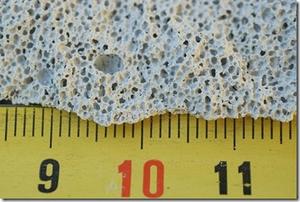InfrastructureBuilding material of millennium: Autoclave Aerated Concrete
Although widespread rebuilding in the hard-hit New York metro region from Hurricane Sandy has not yet begun, New Jersey Institute of Technology (NJIT) scientists say when the hammers start swinging, it is time to look at autoclaved aerated concrete; the material, best known as AAC, has been heralded as the building material of the new millennium

Porous internal structure of AAC // Source: wikipedia.org
Although widespread rebuilding in the hard-hit New York metro region from Hurricane Sandy has not yet begun, New Jersey Institute of Technology (NJIT) assistant professor Mohamed Mahgoub, Ph.D., PE, says when the hammers start swinging, it is time to look at autoclaved aerated concrete. The material, best known as AAC, has been heralded as the building material of the new millennium. It is a lightweight, easily-crafted manufactured stone, strong enough to withstand earthquakes and hurricanes when reinforced with steel.
The material is used widely worldwide, says Mahgoub, who will be a featured speaker early next week at the 2012 China-US BOAO Manufactured Stone Conference in Zhengzhou Henan, China.
A NJIT release reports that Mahgoub is also the coordinator of the NJIT Concrete Industry Management (CIM) program, which is only one of a select few programs of its kind across the United States. This semester CIM students are testing and analyzing AAC. “It is an environmentally-friendly solution for future building problems and it is also an extremely efficient, specialty fabrication material,” he says. “Cuts can easily be factory controlled. AAC is available throughout the U.S. and Canada. There is currently one U.S. manufacturer in Florida with plans to open another manufacturing operation in New Jersey.”
AAC was discovered as a timber alternative in1920 by Dr. Axel Eriksson of the Royal Institute of Technology in Stockholm, Sweden. Currently there are more than 325 worldwide manufacturing plants that annually manufacture more than 25 million cubic yards. China is now in the midst of building more plants. Europeans have been using the material for the past sixty years; Russia is the greatest user. In the United States, its presence has increased over the past fifteen years.
AAC is workable and lightweight like wood. It can provide outstanding thermal insulation, is resistant to fire, termites and decay. A concrete product, AAC consists of finely ground sand, cement, quick lime, gypsum, aluminum and water. “Most sand is too coarse for the manufacturing of AAC,” notes Mahgoub. Mills rotated by 500 horse power electric motors grind the grains up into a finer consistency, then pump the ground material into slurry tanks. The raw slurry is agitated constantly and mixed with water to hydrate the cement and to control the mix consistency.
Aluminum paste or powder, mixed with water, is then introduced. The aluminum slurry is added to the mix and a chemical reaction produces a hydrogen gas that increases the mix volume. The result is a fine cellular structure of the finished product.
AAC can be used as roof, floor, vertical or horizontal wall panels, shaped into blocks and more.
The release notes that the Concrete Industry Management Program at NJIT is designed to address the urgent need for professionals with the skills to meet the growing demands of a progressive, changing concrete industry. The program is part of a special curriculum in the NJIT Department of Engineering Technology in NJIT’s Newark College of Engineering. The program prepares broadly educated, articulate graduates grounded in basic concrete construction management, who are knowledgeable of concrete technology and techniques.
